Juniper care in fall and preparation for winter
All conifers prepare for winter in about the same way, and no special preparation is required - they all winter well. However, there are still some things to do. First of all, they need to be protected from drought, adhesion of snow and sunburn, as well as, if desired and necessary, to feed and perform sanitary pruning.
Let's take a closer look at all the main points regarding the autumn care of the juniper during its preparation for winter.
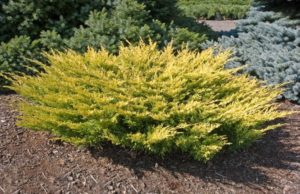
Content
- 1 How to care for a juniper in the fall: the main activities for preparing an ephedra for winter
- 2 Autumn feeding of juniper
- 3 Autumn water-charging irrigation
- 4 Juniper pruning in fall and spring
- 5 Autumn treatment for diseases and pests
- 6 Is it necessary to cover the juniper for the winter: how to properly protect the bushes from snow adhesion and sunburn
How to care for a juniper in the fall: the main activities for preparing an ephedra for winter
So, here's what you need to do with juniper in the fall to properly prepare it for winter:
- feed with autumn fertilizer;
- perform water-charging irrigation;
Advice! Autumn feeding must be done before frost (at least 2 weeks, preferably 3-4, i.e.per month) so that the plant has time to assimilate nutrition, as well as water-charging watering, until the temperature drops below zero at night, and another plus in the daytime.
- carry out sanitary pruning and shaping haircut;
- treat against diseases and pests;
- cover for the winter, more precisely, to protect the needles from adhesion of snow and sunburn, as well as to mulch.
Video: autumn preparation of conifers for winter (including juniper)
Autumn feeding of juniper
In order to better prepare the juniper for winter, to increase winter hardiness, it can be fed with autumn fertilizer, of course, if in the spring you did not give a complex fertilizer of a long (they also say “prolonged”) action.
Worth knowing! Autumn fertilizer is a fertilizer with a high content of phosphorus and potassium (no nitrogen). Superphosphate is suitable as phosphoric, potassium sulfate - potassium sulfate (potassium sulfate).
If you don't want to bother, then you can just buy ready-made fertilizer marked "autumn", and there is a special "Autumn fertilizer for conifers" on sale.
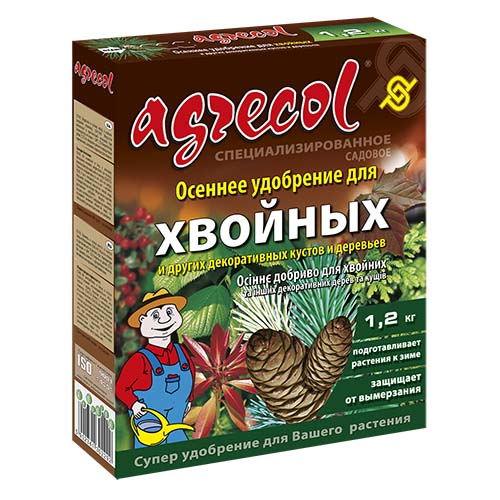
In addition, in the fall, it is highly recommended to carry out foliar feeding of juniper with magnesium, namely, spray the crown of the plant with a solution of magnesium sulfate (10 grams per 10 liters of water). It will be lovely prevention of browning and yellowing of needles due to sunburn due to the accumulation of magnesium by the plant.
Autumn water-charging irrigation
In case of a fall short of precipitation, continue to periodically water your junipers. At the end of the dacha season, be sure to carry out water-charging watering in order to saturate the entire root system of the ephedra with moisture. Then the earthen lump will freeze less, and the juniper will be warmer in winter. And in late autumn and early winter, if it is sunny, he will be able to safely evaporate moisture
Advice! If you have the opportunity, then in early spring or even at the end of winter (in February-March) it is also very desirable to carry out water-charging irrigation with hot water (but not boiling water) in order to saturate the ephedra root system at the most necessary moment - when there is increased evaporation. This will help prevent the needles from drying out and yellowing (sunburn).
Important! If on your site high groundwater (1.2-1 meters), then it is not recommended to do water-charging watering. But sprinkling of the crown can be done in early spring (i.e. deliver moisture directly to the needles).
Juniper pruning in fall and spring
Juniper does not need pruning as such, another thing is that every autumn and spring should be carried out sanitary pruningcutting out dead and broken branches, and clean wood from dry old needles.
If you made a hedge of junipers or formed it in the form of a column (made some kind of topiary or curly haircut), then in the fall you can slightly correct its shape and trim the protruding branches.
Essential oils found in juniper resin are quite caustic (if they get on your hands, irritation may remain), so pruning should be done only in thick canvas gloves and closed clothing.
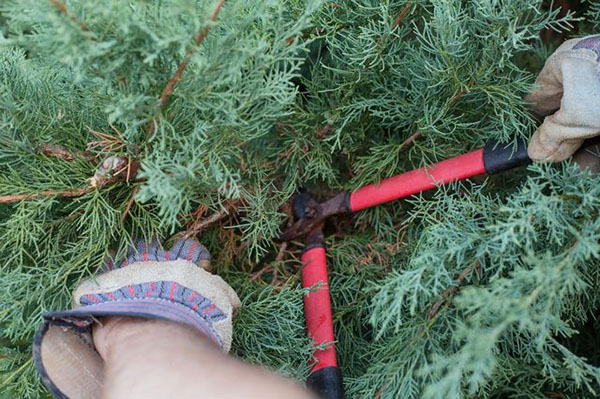
Autumn treatment for diseases and pests
If autumn is warm and humid, then spraying juniper against diseases (fungal) is simply necessary.
In other words, if during the examination you notice that fungi and pests are present on the bushes, you can carry out both preventive treatment and eradicating.
As a rule, most often treatment for fungal diseases is carried out copper sulfate or bordeaux liquid (but in a very weak concentration, about 100 g per 10 liters - for treatment, 50 g per 10 liters - for prophylaxis), or with special preparations like Hom, Abiga-peak (both based on copper oxychloride). However, it was in the fall handle ephedra well iron vitriol (also not more than 1% solution), not copper.
From pests you can use insecticides such as Intavir, Fufanon (according to the instructions).
Also, sulfur-based preparations - Colloidal sulfur, Tiovit jet (according to the instructions) are suitable for the autumn treatment of conifers from diseases and pests.
And you can also spend complex treatment against diseases and pests, for example, Horus (fungicide for diseases) and Aktara (insecticide for pests). Moreover, you can mix both drugs at once, i.e. prepare the tank mixture.
Is it necessary to cover the juniper for the winter: how to properly protect the bushes from snow adhesion and sunburn
Advice! You can use almost any loose material as mulch: peat, coniferous litter, coniferous bark, compost, humus, sawdust, dry leaves.The minimum thickness of the mulch layer is 5 cm.
But a juniper, formed in the form of a column (columnar), or just very sprawling bush (having a curly or topiary haircut)may suffer during heavy snowfalls - stuck snow can break its branches... Therefore, you need to either regularly shake the snow off the branches, or even better in autumn tie (pull) the juniper in a circle with twine or twine (from bottom to top in a spiral), bending the side branches to the main trunk.
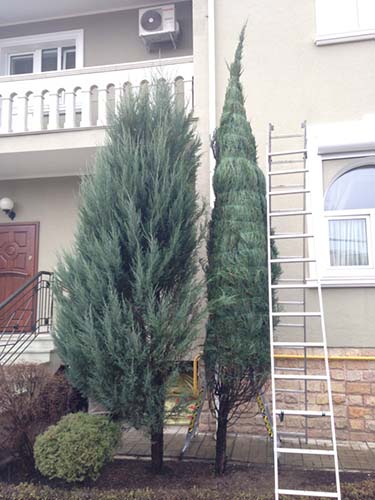
Video: preparing juniper for winter - protection against snow adhesion
- If you have not sprawling bushes juniper and you live in quite cold but snowy region, then for better insulation you can throw snow over the crown.
- If winters are often frosty and with little snow, then it is also advisable to cover young plants from above with spruce branches, which will retain snow.
In the early spring period, junipers are very often needles get sunburn (especially if they grow in open areas), so for the winter it is desirable somehow protect plants from excessive sunlight.
Because of what this happens: the sun begins to bake the crown, the needles more actively evaporate moisture, and the root system of the plant does not work, because is in a frozen state, as a result, the needles dry out and turn yellow (not immediately, but towards the end of spring).
In other words, you can cover your plants in early spring if you don't want to do it in autumn.
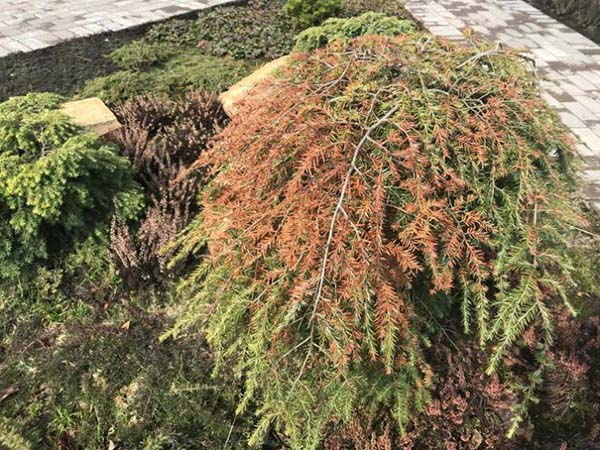
How to cover a juniperto protect against sunburn?
- Anyone will do for this. reflective materiale.g. gauze, kraft paper, white cotton fabric (bed sheet, duvet cover), polypropylene bags, burlap, polymer net.
Idea! And for the winter, the juniper can be covered with foil insulation (shiny side out).
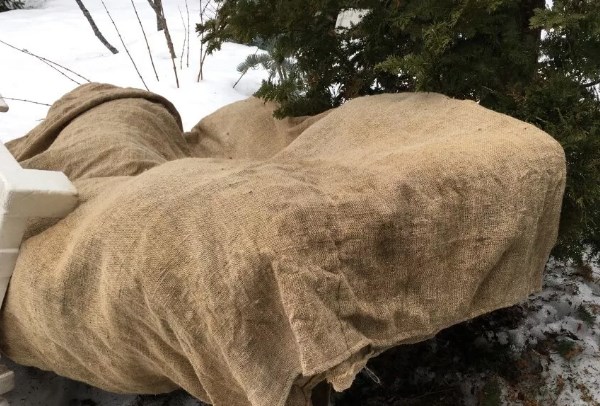
Note! Some gardeners recommend using nonwovens and various agrofibers (spunbond, lutrasil) for sheltering juniper. However, they let in ultraviolet rays! Therefore, they can only protect against snow adhesion, but not from the sun. Under them, the plant will definitely get burns.
- Also on sale you can find ready-made conical caps (suitable for columnar junipers), they can be quickly dressed on all conifers.
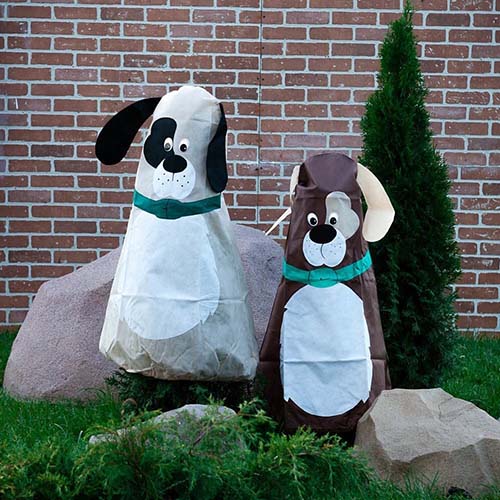
- The most the best and most effective way to protect young and short junipers and other conifers from sunburn is the use sun screens.For example, you can make doughs and stretch a special protective reflective material on them.
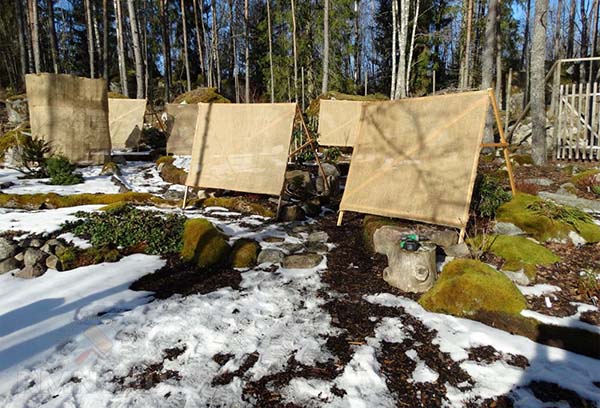
Video: shelter of conifers - the best covering materials
Thus, now you know what activities you need to carry out in the fall in order to properly prepare the juniper for winter.If you do everything right, then in the spring the plant will again delight you with its decorative appearance (and not upset with burnt-out needles or broken branches).
Video: how to prepare conifers for winter

